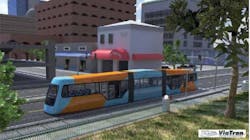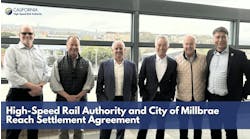Riverside, Calif., City Council takes first step in bringing zero-emission streetcar concept along with company headquarters
A proposal to take the first critical step towards the first alignment of an innovative, self-powered and sustainable streetcar line was approved by the Riverside City Council in California
The proposal, brought forward by Councilmember Ronaldo Fierro (Ward 3), would implement the line in Riverside’s Innovation District, which will eventually connect all of Riverside’s sprawled neighborhoods.
The proposal builds off engagement and conversations with TIG/m, a company from Chatsworth, Calif., that specializes in designing and manufacturing electric streetcars that do not require overhead wire or other wayside power systems. The company has also committed to moving their headquarters from Chatsworth to Riverside, bringing with them 150 highly paid green jobs. This will allow TIG/m to serve as an anchor of the recently approved Innovation District and will complement the anticipated opening of the Southern California Headquarters of the California Air Resources Board (CARB) in Riverside. The establishment of a streetcar line within the city of Riverside tackles multiple policy problems that the city of Riverside faces, ranging from economic development to addressing the need for new electric transportation options in the face of a growing climate crisis, prompted by California Gov. Gavin Newsom’s recent Executive Order banning the sale of gas-powered vehicles by 2035.
“If the city of Riverside is truly to live up to our slogan—The City of Arts and Innovation’ – we must begin to solve the crises of our time through innovation,” said Councilmember Ronaldo Fierro. “These are housing, mobility and climate change. This proposal addresses all three and will spur further solutions and investments in our city.”
An initial study of a streetcar concept in Riverside in 2017 estimated that a streetcar could spur development of 9,000 residential units and seven-million-square feet of commercial space and the creation of 15,000 new jobs.
“The number one goal of any public transportation system is to get people out of their private automobiles by giving them a complete end-to-end solution for their travels; creating a communal sense of place that is a connected, walkable, exciting place to be,” wrote TIG/m CEO Brad Reed in the feasibility study proposal. “This is done by connecting all of the alternate modes of travel into a seamless whole. In the case of the Riverside Streetcar, this means making as many stops as possible for a multi-modal stop for buses, streetcars, and bicycles. These three modes support one another. When we give motorists a viable opportunity to leave their cars at home all three of these modes of travel will see increased ridership.”
In November 2020, the city council will be presented with a finalized budget for the study as well as a contract with TIG/m for approval in November 2020. The feasibility study will take approximately 16 weeks, resulting in a completed alignment design, ridership projections, cost/benefit analysis, a community benefits analysis and cost projections and project financing options.


